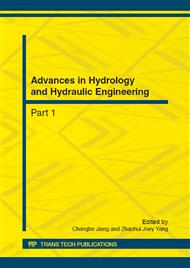p.647
p.653
p.658
p.664
p.671
p.679
p.684
p.688
p.692
Research on Influencing Factors of Drainage Performance in Engineering
Abstract:
In order to control the seepage and eliminate the adverse effects, influencing factors of drainage in engineering are discussed in this paper. The drainage holes are simulated by rod element to study the influence of drainage performance on angle and length. Compared the drainage performance of drainage galleries in different location, the optimal assembly is obtained. Meanwhile, drainage performance is analyzed by different permeability coefficient and anisotropy of rock and soil mass. The results show that: (1) Drainage flow of small angle and short drainage hole is close to big angle and long one, the small angle flows more than the big angle when increasing the same length. (2) Shallow drainage galleries can significantly drop the free surface and the deep one can greatly decrease the pore water pressure. Drainage galleries built at the upstream side and bottom, as the optimum assembly, can enormously change the seepage field. (3) For anisotropy materials, the horizontal drainage performance is better than vertical when Ky/Kx decreases. On the contrary, vertical is superior to the horizontal. Increasing vertical permeability coefficient is benefit to drainage.
Info:
Periodical:
Pages:
671-678
Citation:
Online since:
October 2012
Authors:
Price:
Сopyright:
© 2012 Trans Tech Publications Ltd. All Rights Reserved
Share:
Citation:


